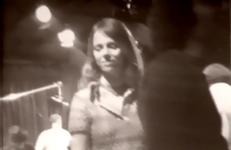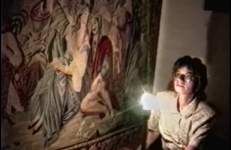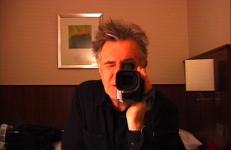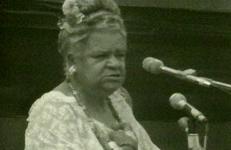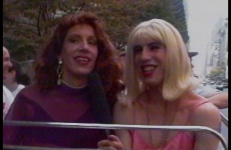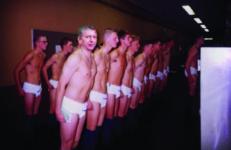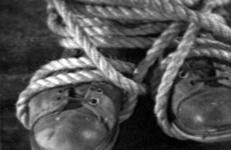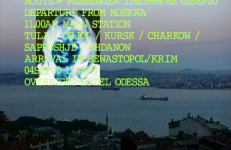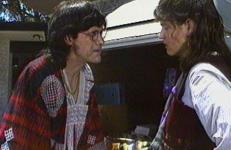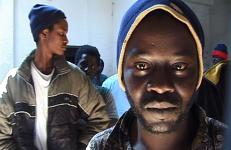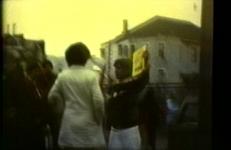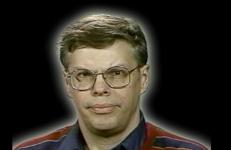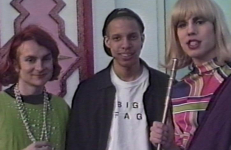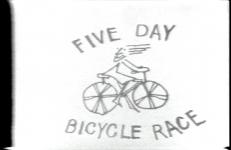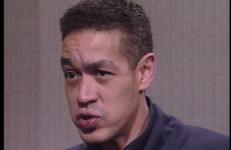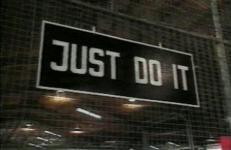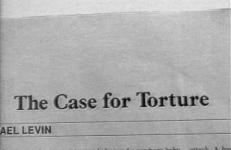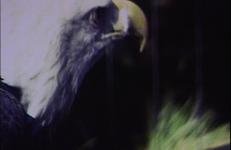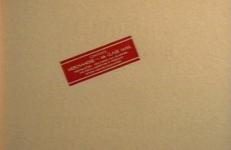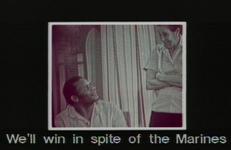This tape, shot in April 1971, documents the making of a WNET/13 TV show about video collectives and how they use the new video technology.
Politics
Susan Mogul's first video diary work, produced two years before Everyday Echo Street: A Summer Diary (1993), follows the artist on a trip though Eastern Europe immediately after the fall of the USSR. Through discussions with various characters about politics, art, and each others personal lives, Mogul creates a video time capsule of social life in Poland, then Czechoslovakia, and former Yugoslavia.
Netherlands, January 29th 2006/January 29th 2007
Hamas have just won the Palestinian elections and a chocolate bar in a Rotterdam hotel room eventually reminds the filmmaker that there are more important things going on in the world outside. Exactly one year later he returns to the same city and checks in at a very different hotel. Pyramids/Skunk is a double episode in the Hotel Diaries series, a collection of video recordings made in the world’s hotel rooms, which relate personal experiences and reflections to contemporary conflicts in the Middle East.
Two years after the riots and deaths at Attica, New York, a community day was organized at Greenhaven, a federal prison in Connecticut. Think Tank, a prisoners' group, coordinated efforts with African-American community members outside the prison walls to fight racism and poverty. The event was documented by People's Communication Network, a community video group founded by Bill Stephens, for cablecast in New York City, marking the first time an alternative video collective was allowed to document an event inside prison walls.
In Queens on the Media Scene, East Village drag queen Linda Simpson (of My Comrade zine) joins Glennda to discuss the explosion of drag in the mainstream media, and the pair interview passers-by on the streets of Midtown Manhattan. They discuss the rising acceptance of drag in the mainstream, in part due to the media presence of RuPaul; the potential taming of drag or its normalization; and an ambition to preserve the more taboo aspects of drag expression in the face of increasing popularization.
Ram Dass, born Richard Alpert, was a spiritual guru and crucial figure in the early research of psychedelics alongside Timothy Leary in the 1960s–70s. In the early 70s, he gave a lecture at the Art Institute of Chicago. He began by mentioning a recent interaction with Sidney Cohen with whom he had co-authored the book LSD (1966). Ram Dass discussed being on a panel with Cohen about substance use in Washington D.C.
Based on a set of drawings that depict George W. Bush's administration as wounded soldiers in the war against terrorism, RE:THE_OPERATION explores the sexual and philosophical dynamics of war through the lives of the members as they physically engage each other and the "enemy." Letters, notes, and digital snapshots "produced" by the members on their tour of duty become the basis of video portraits that articulate the neuroses and obsessions compelling them toward an infinite war.
The Red Tapes is a three-part epic that features the diary musings of a committed outsider: revolutionary, prisoner, artist. The series offers a fragmented mythic narrative and a poetic reassessment of the radical social and aesthetic aspirations of the previous decade. Acconci maps a “topography of the self,” constructing scenes that suggest both the intimate video space of close-up and the panoramic landscape of film space.
In Biemann’s film, she traces the routes and reasons of women who travel across the globe for work in the sex industry. By using the latest images from NASA satellites, the film investigates the consequences of the U.S. military presence in southeast Asia as well as European migration politics. This essay takes an earthly perspective on cross-border circuits, where women have emerged as key actors and expertly links new geographic technologies to the sexualization and displacement of women on a global scale.
Featuring Ricky and Cecelia from Wendy Clarke's One on One video series, this video exchange between the pair explores topics concerning sibling love, decaying family relationships, and a shared interest in professional football. Although brief compared to the other parts within the One on One series, there is a glimmer of genuine human connection in their words.
“The Riot Tapes is a video biography of Segalove’s political involvement in college, of her boyfriend (who became anorexic while dieting to evade the draft), and of her discovery that art could give her a voice and a forum for her political views. It is her first real political work. Segalove says, ‘I’m trying to comment on the state of things. A lot of my peers spend a lot of time in a state of disbelief, but I’m tired of disengaging myself from the world by doing that.’”
—Gloria Ohland, “Segalove’s Latest Is a Riot,” L.A. Weekly 6:22 (27 April 1984)
Sahara Chronicle encompasses an undefined number of short videos documenting the present sub-Saharan exodus towards Europe. Taking a close look at the modalities and logistics of the migration system in the Sahara, the project examines the politics of mobility, visibility and containment which lie at the heart of current global geopolitics. The material is gathered during three field trips to major gates and nodes of the trans-Saharan network in Morocco, Mauritania and Niger where migratory intensity is bundled. No voice-over narrative strings these stories together.
Scenes from an Endless War is an experimental documentary on militarism, globalization, and the "war against terrorism." Part meditation, part commentary, Scenes employs recontextualized commercial images, rewritten news crawls, and original footage and interviews to question received wisdom and common sense assumptions about current American policies.
A meditation on maritime trade routes, SEA – SHIPPING – SUN is a short film directed by Tiffany Sia (b. Hong Kong) and Yuri Pattison (b. Dublin) shot over the span of two years to render a simulated duration of a day, beginning at twilight and closing at sunset. The film is set against shipping forecasts from archival BBC Radio 4 broadcasts. The sun emerges and disappears, again and again.
A meditation on maritime trade routes, SEA – SHIPPING – SUN is a short film directed by Tiffany Sia (b. Hong Kong) and Yuri Pattison (b. Dublin) shot over the span of two years to render a simulated duration of a day, beginning at twilight and closing at sunset. The film is set against shipping forecasts from archival BBC Radio 4 broadcasts. The sun emerges and disappears, again and again.
Reading the billboards, the cars, the people, and the graffiti of the street as cultural signs, Rosler extracts the network of social power and domination that determines whose culture gets represented where, asking whose culture is reported in the press and whose is forced to exist in the street?
Security Anthem’s requisite components came together relatively slowly. I’d known for years that I wanted to make something out of the Oto speakers’ most sinister, suggestive sentences. I’d taught myself to program music on a Game Boy using a cartridge I’d bought from a Swedish programmer, and I composed a sequence of ominous music that seemed well-matched to the speakers. I’d recorded John Ashcroft singing his self-penned song “Let the Eagle Soar” through a media player window, and I knew that it somehow belonged with the speakers and the 8-bit music.
In this episode of The Brenda and Glennda Show, Brenda and Glennda lead a group of drag queens on a trip to Donald Trump’s Taj Mahal Hotel & Casino in Atlantic City. Intended to be a drag queen gambling getaway and a public stage for drag visibilty, the trip turns into a moment of protest and reflection incited by homophobic discrimination. The group is kicked out of the gambling area for supposedly wearing excessive makeup and inapprorpiate, flashy attire — somehow unlike and worse than that of the casino's showgirls and other heavily powdered female patrons.
A collage of informal interviews and short clips, this collection of material comes from guerilla TV excursions at the 1976 Democratic National Convention. Conducted off hand, usually amidst crowds of other journalists, the footage oscillates between slight antagonisms, genuine interest, and tongue-in-cheek play. The sheer breadth of participants being engaged with, however, is quite impressive as the soon-to-be First Lady, Jesse Jackson, David Dellinger, Bella Abzug and Jerry Brown all make appearances.
Andres Serrano was born and raised in New York. At fifteen he dropped out of high school. A few years later he attended the Brooklyn Museum School and studied painting and sculpture. After two years, Serrano decided that neither of these art forms were appropriate for his particular vision, and began to make photographs. Serrano’s work came to the attention of the general public as part of the controversy surrounding the issue of censorship and the NEA.
Short Circuit is an experimental documentary—a semi-autobiographical rant that challenges the obsolescence of human labor at the vortex of the machine and digital ages. Through a flow of images, text, and sound, the mechanical and the electronic clash in the thought processes of our protagonist. Is the global revolt of the machines at hand?
Rosler identifies the totalitarian implications of an argument for torture, under certain circumstances, as it appears as a guest editorial in Newsweek magazine in 1982. Her critique is presented as a voiceover and a dizzying assemblage of radio and print media--articles on subjects ranging from human rights to unemployment and global economics. Implicating the U.S.
In turns funny, disturbing, and glisteningly sensual, small lies, Big Truth is a tape about love, relationships, and the joy and banality of sex in the late 20th Century. It also touches on such issues as morality, voyeurism, nature vs. culture, and power, as eight people read fragments from the testimony of William Jefferson Clinton and Monica S. Lewinsky, as published in the Starr Report.
For the past 20 years Alexis Smith's mixed media work has explored primal American myths: the open road, the bad/good guy/gal, the quest for romance, and the search for paradise. This portrait of the artist explores the roots of her thought and work, and was produced in conjunction with her exhibition at the Whitney Museum of American Art, held in November 1991.
Horizontes incorporates scenes from a popular Cuban soap opera with running commentary in the form of a propagandistic advertising text. Blumenthal examines media programming as presenting, through the filter of a generalized moralism, a reconstructed history that mirrors the values of the dominant class. The media both "collects and corrects public memory."
Available in Spanish and English.
This title is also available on Lyn Blumenthal Videoworks: Volume 1.




